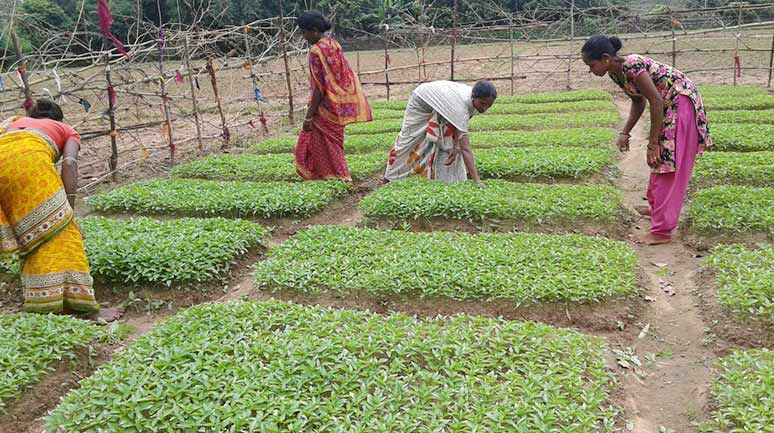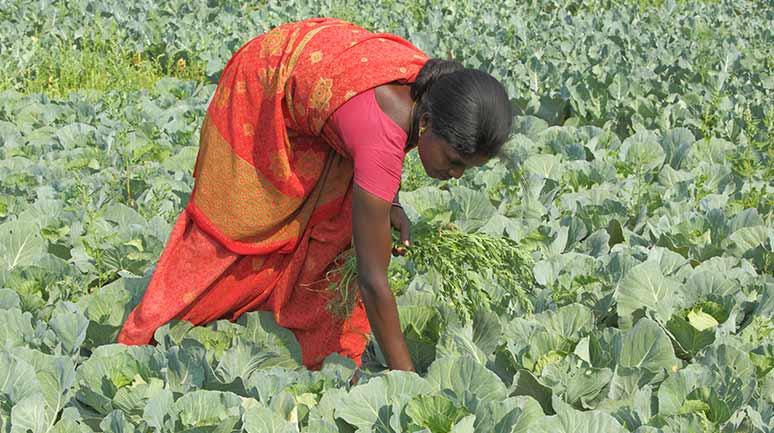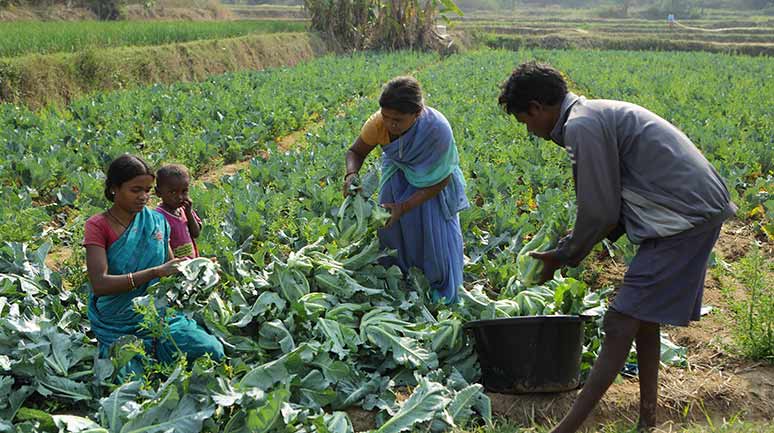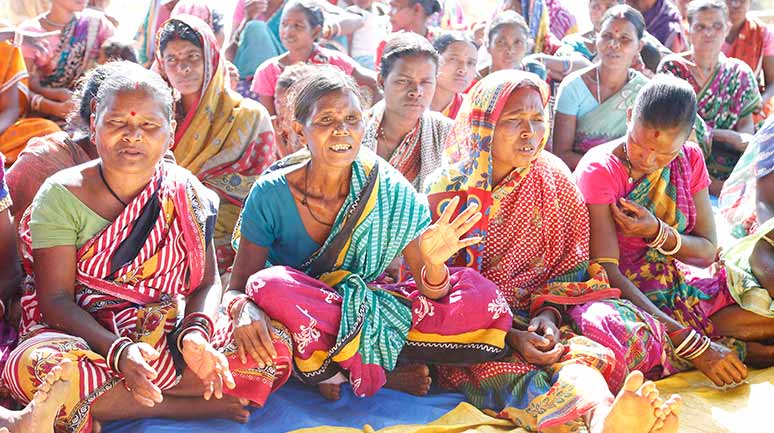Collective Farming: Creating an Identity for Women Farmers


Applying their minds to adopting improved agricultural practices and shifting to vegetable cultivation on a large scale through collective farming, the women of Gaudaguda village unite to change not only agricultural practices but also show their potential at organizing themselves by bringing the market to their doorsteps, thereby streamlining processes
When i decided to cultivate brinjal in 80 decimals of land that was earlier used for cotton production, my husband got very angry with me. He asked me how I would sell such a huge quantity of brinjal and told me that I would have to give him Rs 30,000 in case of failure. He did not support me in the any farm-related activity. I took up the challenge because my Sangha had decided to bring the market to our doorsteps. I earned Rs 80,000 from brinjal cultivation. If I were to add the value of the brinjal I distributed to my relatives and consumed, it would cross Rs 1 lakh. My husband and I are very happy. He is not talking about money anymore; it’s now in my hands and I can use it as per my choice,” said Palai Jiraka with pride.
Palai Jiraka, a tribal woman, lives in Gaudaguda village in Kolnara block, Rayagada district, Odisha. She cultivated cotton every year. After joining a Self-Help Group (SHG), she started vegetable cultivation. Owing to the difficulty in marketing her produce, she cultivated in a small piece of land. Every year, she cultivated cotton in that land and earned around Rs 30000. This year, she earned Rs 80000 from the same piece of land because of the marketing support provided by her farmers collective. She has full control now over the income.
Background
Kolnara block of Rayagada district is a tribal-dominated block where more than 72 per cent of the population is tribal. Of these, a majority belong to the “kandha” tribe and speak both Kui and Telegu languages. They depend mostly on agriculture, dongar (shifting cultivation in the hills) cultivation, on non-timber forest products (NTFP), livestock and wage labour for their livelihood. In these five traditional livelihood activities, women contribute the major work force; men, however, are the lead decision- makers in the family. Men usually plough the land, rear bullocks, buffalos and small ruminants and sometimes go to the forest to collect wood. In agriculture, paddy is the primary focus of every household, followed by cotton. Men favour cotton cultivation because they get bulk cash readily in their hands when they sell the produce. Cotton is a labour-intensive crop and women do most of the work. Women do not favour cotton cultivation because of the drudgery involved; they would rather grow pigeon pea or vegetables, from which they can both earn money and get food. Men, on the other hand, do not value the labour that women do and their contribution remains unnoticed. Semanti Mandangi from Pujariguda village says “My husband is the decision-maker; I follow what he says. I wish to cultivate vegetables in half an acre of land where we grow cotton, but it’s up to him. If he agrees, only then can I do it. I can’t take decision on my own.”
Women seldom get recognition as farmers despite doing most of the drudgery ridden work in farming. Further, subsequent to this, a woman’s position becomes vulnerable in the farm and family as well.

As long as the self-view of women does not develop, we realized that their role as economic contributors to the family will remain unrecognized. The women themselves have to create space for this. When this was discussed across SHGs, we found that women do not consider themselves as farmers and see their contribution only as another household task. Initially, most of the participants had a strong view that men are the farmers and when they were asked to draw a picture of a farmer they drew the pictures of men only. We then conducted a work division exercise in farming (here we consolidated different tasks done by men and women in paddy cultivation). After the exercise, the women were amazed to notice the magnitude of their contribution. Despite this, they however, said that because they cannot decide what crop to cultivate, what inputs need to be given, they follow what their husbands or other male members in their families ask them to do. Their contribution, although mammoth, is largely limited to labour work. The discussions concluded with the women arriving at some of these basic action points:
- We, as farmers, will take decisions about farming, both for balanced food sufficiency and income.
- We will develop our skills in different and better processes of agriculture.
- We will collectively develop a relationship with different stakeholders such as the market, agriculture department and bank.
- We will together open individual accounts in the bank and save money in our own accounts.
- We will reduce our drudgery in agriculture through mechanization and take required rest
Through collective farming, women would first create respect for themselves as farmers through enhancing their decision-making ability; develop their skills and knowledge; establish linkages with different government programmes and engage in collective input procurement, collective farming and collective marketing.
Through collective farming, women would first create respect for themselves as farmers through enhancing their decision-making ability; develop their skills and knowledge; establish linkages with different government programmes and engage in collective input procurement, collective farming and collective marketing.
ooking at these realities and issues, attempts have been made to get recognition for women farmers through collective farming. With the support of the Mahila Kisan Sashatikaran Pariyojana (MKSP), producer groups were formed in 51 villages. These village-level producer groups were further collectivized in three production clusters in Kolnara block. All the SHG members were members of the producer group. Some landless families were also included in agricultural activity through social arrangement and the land leasing system.
Several rounds of visioning exercises were conducted, both at the village level and at the cluster level, covering the entire block to define the objectives of the collectivization in agriculture. Through collective farming, women would first create respect for themselves as farmers through enhancing their decision-making ability; develop their skills and knowledge; establish linkages with different government programmes and engage in collective input procurement, collective farming and collective marketing.
Women collectively decided to cultivate vegetables for a cash income, and paddy and pulses for food. It was not easy for the women to negotiate with their husbands about their choice of crops. However, because the Women were collectively involved, they convinced their husbands to allow them to cultivate a small part of their land as per their choice. The women then procured input material; they were given technical training on the package of practices for different crops and were provided handholding support by trained community resource persons (CRPs). Forums such as the farmer learning school, the producer groups in the village and the clusters at the block level became the platform for sharing, learning and decision-making, for the women.
Many women farmers started intensive cultivation of vegetables and managed a good yield. However, they were still apprehensive of cultivating vegetables on a large scale and the average cultivable area remained below 10 decimals. When we explored the causes of this stagnation in different forums such as farmer learning consolidation meetings, CRP reflection meetings and cluster meetings, the marketing issue came up first. They said, “We are not able to sell our vegetables for a better price; if we cultivate in big patches, who will buy the vegetables from us?” They sold their produce in the local market or in the village but were not able to fetch a good price. A few who were adept at negotiating were able to get good returns but most of the women were unequipped. That they had to carry vegetables and stay in the market for the whole day increased their drudgery. Therefore, they restricted themselves to smaller plots, cultivating vegetables mainly for household consumption. We saw farmers cultivating brinjal in more than 2 acres and earning around 2 lakhs per annum in rain-fed situations. There were systems of assured forward and backward linkages at their doorsteps.
We saw farmers cultivating brinjal in more than 2 acres and earning around 2 lakhs per annum in rain-fed situations. There were systems of assured forward and backward linkages at their doorsteps
Taking these factors into consideration, we explored some places where farmers had earned a substantial income from this agricultural activity. Women representatives and PRADAN visited Bandapipili village in Kandhamal district to see farmers doing large-scale vegetable cultivation. Bandapipili had people from different communities farming collectively. The visit was an eye-opener for the women farmers and for us. We saw farmers cultivating brinjal in more than 2 acres and earning around 2 lakhs per annum in rain-fed situations. There were systems of assured forward and backward linkages at their doorsteps. This experience has strengthened our resolve more to focus on creating a sustainable system in our area.

On returning, the representatives of the farmers’ collective discussed the drawbacks of the present mode of agriculture and tried to generate different options for improving the situation. Women discussed establishing a marketing system so that they could sell their vegetables at their doorsteps easily. They thought about selecting some service providers or community entrepreneurs to support them in the marketing system. They also consulted different local traders, to select those varieties of major crops that have a better market demand. Having done the background work, they organized a general body meeting of all farmers of their farmers’ collective, to prepare the roadmap for a new way of agriculture with the slogan, “Chinta hateiba, rojgar badheiba (Eliminate tension, increase income).” The farmers openly discussed their challenges and arrived at the following few consensual decisions:
- Cultivate one or two crops intensively, suitable for the area, so that these could be produced in volume for the market.
- The farmers will cultivate vegetables in at least 20 decimals of land, with an average of 20 farmers per village, in a contiguous patch in 8 to 10 villages.
- Vegetable cultivation to be initiated early, to benefit from the maximum market price. The farmers’ collectives decided a specific time for each cluster, to complete the preparation of the nursery.
- The general body of the farmers’ collectives defined the role of different cadres, to support women farmers.
Initiatives by the Collectives in the Pre-Production Stage
Input at the doorstep: Women farmers got quality agriculture inputs such as seeds and some medicines at their doorstep without any tension or transportation cost. Women’s collectives help prepare the crop plan for each member, based on the season, farmer suitability and market attractiveness, and also make a collective plan for their cluster. Accordingly, the collectives engage community entrepreneurs, to purchase quality inputs in bulk and supply these to farmers at their doorstep.
Table 1: Production Clusters at a Glance
| Name of the Cluster | Number of Villages | Number of Families | Crops Cultivated | Average Area (in Acres) | Date for Nursery |
|---|---|---|---|---|---|
| Dumuriguda | 10 | 170 | Brinjal, Chilli | 30 | 2nd week of June |
| Mukundpur | 11 | 198 | Brinjal, Chilli, Beans | 32.2 | 1st week of June |
| Suri | 4 | 52 | Brinjal, Chilli | 7.7 | 2nd week of June |
| Gadesiskal | 5 | 115 | Brinjal, Chilli | 14 | 2nd week of June |
| Total | 30 | 535 | 84 |
Women farmers adopted different integrated pest management (IPM) practices of mixed cropping, broader cropping and organic pesticides, to protect their plants from diseases and pests. Because farmers are cultivating crops in big patches, they collectively initiated preventive measures on their farms .
Women farmers adopted different integrated pest management (IPM) practices of mixed cropping, broader cropping and organic pesticides, to protect their plants from diseases and pests. Because farmers are cultivating crops in big patches, they collectively initiated preventive measures on their farms
Increase in the area of cultivation: Once input supply and marketing at the doorsteps was assured, women farmers increased their area of vegetable cultivation from the average 15 decimals to 25 decimals. Some producer groups and village organizations (VOs) arranged land for the landless through some social arrangement or the seasonal leasing system.
Kami Patika and Usha Patika of Bandhaguda village of Mukundpur cluster are landless widow farmers. Earlier, they were cultivating vegetables in 5-10 decimals; this time, they took 1 acre of land on lease jointly by paying Rs 2000, and cultivated brinjal and chilli.
Community nursery and early initiation of agriculture activity: The collectives raised community nurseries at the village level, which ensured that good quality seedlings were available for the farmers at particular times. It also ensured proper monitoring of nurseries by members and CRPs. To maximize their profit, the farmers are cultivating early crops. With timely inputs and community nurseries, farmers ensured that they start harvesting crops 20 days prior to the usual time.
Use of farm implements: When farmers started cultivating on large areas of land and in contiguous patches, they needed to use farm implements such as power weeders, power sprayers, and battery sprayers.
Initiatives by the Collectives in the Production Stage
CRP system: CRPs are selected from SHGs and groomed on different better practices of agriculture through the practical use of information, education and communication (IEC) material. Being the resource persons or experts of their villages, they helped other farmers on a voluntary basis to build the capacity of other farmers. Their efforts in the field with farmers helped ensure different practices in agriculture.
IPM practices: Women farmers adopted different integrated pest management (IPM) practices of mixed cropping, broader cropping and organic pesticides, to protect their plants from diseases and pests. Because farmers are cultivating crops in big patches, they collectively initiated preventive measures on their farms. For plant growth, timely weeding and ridging operations along with fertilizer applications are ensured.
Organic medicine selling: Farmers found it difficult for all farmers to prepare different organic medicines on their own. Some community entrepreneurs prepared organic medicines such as Agniastra, Mahulastra and Mahaphal and sold it at affordable prices at the village level. Collectives have become the drivers of this process, taking decisions at every level. Co-ordination meetings were held regularly between representatives and the villagers to take stock of the whole process. It includes timely vehicle arrivals, and deciding on different markets, based on the volume of production, demand and market rate.
Collectives have become the drivers of this process, taking decisions at every level. Co-ordination meetings were held regularly between representatives and the villagers to take stock of the whole process. It includes timely vehicle arrivals, and deciding on different markets, based on the volume of production, demand and market rate

Initiatives by the Collectives in the Marketing Stage
Market exploration: Women farmer representatives and village-level community entrepreneurs visited different markets and tried to understand the system and rules of the market. They compared the suitability of different traders and shared in community meetings.
This process helped farmers to broaden their knowledge about the price difference between retail selling and collective marketing.
General body meeting of farmers’ collectives: A general body meeting of women farmers was conducted, to finalize the system and process marketing in their cluster. All the entrepreneurs and traders were called to these meetings, to discuss potential production, collection centre, packing systems, payment mechanism, etc.
Sorting, grading and packing: A high-quality product has its own demand in the market. The farmers and village-level entrepreneurs, therefore, took the responsibility to ensure quality packing of different crops. The farmers sorted, graded and packed the products at the village level. Because of this intervention, produce of different quality is packed separately and sold in the market. This has created a reputation of reliability about the women farmers of the area. In Nandpur village, farmers earlier sold tomato in bamboo baskets of different sizes; this has now been replaced with baskets of uniform size.
Record-keeping: Records are maintained meticulously at the village for input supply, production and the amount received after the sale of crops. Farmers are given receipts for the payments they make. Along with this, electronic weighing machines have been introduced for accurate measurement of the produce. Payment against the sale of the produce is recorded and handed directly to the women farmers, thus establishing their identity.
Monitoring and evaluation of the process: Representatives of the women’s collectives have become the drivers of this process, taking decisions at every level. Co-ordination meetings were held regularly between representatives and the villagers to take stock of the whole process. It includes timely vehicle arrivals, and deciding on different markets, based on the volume of production, demand and market rate.
Bandhaguda: Journey of Women Farmers
Bandhaguda is a tribal village comprising 40 households. It has around 60 per cent widows, and barring eight families, others are landless. The villagers were dependent on wage labour work for their livelihood. In 2009, two SHGs were formed in the village and eventually nine members initiated vegetable cultivation and earned Rs 7–10,000. That influenced other SHG members to take up vegetable cultivation. After the initiation of the women’s identity as farmers training in the village, 30 women SHG members were motivated to do farming and formed a producer group. They have been cultivating tomato, chilli and beans for consumption and cash income purposes. This continued for some years; however, gradually the income they were getting from agriculture was not sufficient to meet the needs and aspirations of the family. In 2016, seven women representatives of the village visited Bandapipili village in the same block to see how collective farming operates and what system had been established.
Table 2: Production and Income Earned by Two Clusters in Kolnara Block
| Name of the Agriculture Production Cluster | No.of Women Producers | Brinjal Production (in Quintals) | Average Rate/Kg | Amount(in Lakhs) | Chilli Production(in Quintals) | Average Rate/Kg | Total Amount | Beans Production (in Quintals) | Average Rate/Kg | Total Amount in Rs | Grand Total in Lakhs |
|---|---|---|---|---|---|---|---|---|---|---|---|
| Mukundpur | 140 | 400 | 9.5 | 3.8 | 20 | 28 | 0.56 | 83 | 26 | 2.158 | 6.5 |
| Dumuriguda | 120 | 450 | 9.5 | 4.3 | 28 | 28 | 0.78 | 5.1 |
In 2017, they produced 40 tons of vegetables and generated an income of more than 5 lakhs besides having adequate vegetables for their own consumption and distribution to relatives. This successful demonstration of collective farming has given the village the identity of a model village in the area
In 2017, they produced 40 tons of vegetables and generated an income of more than 5 lakhs besides having adequate vegetables for their own consumption and distribution to relatives. This successful demonstration of collective farming has given the village the identity of a model village in the area
On their return, the villagers took on the lead role and influenced other villages to change the agriculture scenario. After discussions about the backward and forward marketing system, the villagers planned kharif vegetables in big patches of land. They included 38 women farmers out of 40 families of the village in vegetable cultivation through land social arrangement and leasing system. They cultivated brinjal in 9 acres, chilli in 2 acres and beans in 1 acre of land. They ensured early initiation of nursery, community nursery and IPM practices. Through the efforts of the villagers and the support of the village- level entrepreneur, a pick-up started coming to the village to collect vegetables. In 2017, they produced 40 tons of vegetables and generated an income of more than 5 lakhs besides having adequate vegetables for their own consumption and distribution to relatives. This successful demonstration of collective farming has given the village the identity of a model village in the area.
Kumari Kadraka, a women farmer of the village, speaks about her experience: “I was involved in agriculture for long but due to the fear of marketing and landlessness, I had always done farming in a small area and was earning Rs 10,000 at best. This year, however, due to the efforts of the collective, we have cultivated vegetables in big plots by taking the land on lease. I earned Rs 50,000 from selling vegetables. My husband never used to help me in agriculture; this time, however, after seeing the plot, he has reduced alcohol consumption and started helping me. With the money earned from vegetables, I purchased an LED TV for my house for Rs 15,000. I now enjoy watching television with my husband in my leisure time.
Through collective farming, women are finding new energy and confidence to do farming on their own. This has changed the identity of small and marginal women farmers from being domestic labour to producers in the family and the area. Furthermore, the efforts of women farmers to bring the market to their doorsteps has reestablished agriculture as a viable source of livelihood. It has demonstrated the strength of unity through the self-operated system of collective farming and marketing. Moreover, it has demonstrated a path to get substantial income from agriculture. However, there is scope for adding value to various stages in the future. The process of collective farming has the potential to grow as an Agriculture Production Cluster. However, the collective needs to ensure more linkages network with the market and also converge with different government programmes and departments, to access different schemes for its women farmers.
Jagat Barik is based in Rayagada district, Odisha

